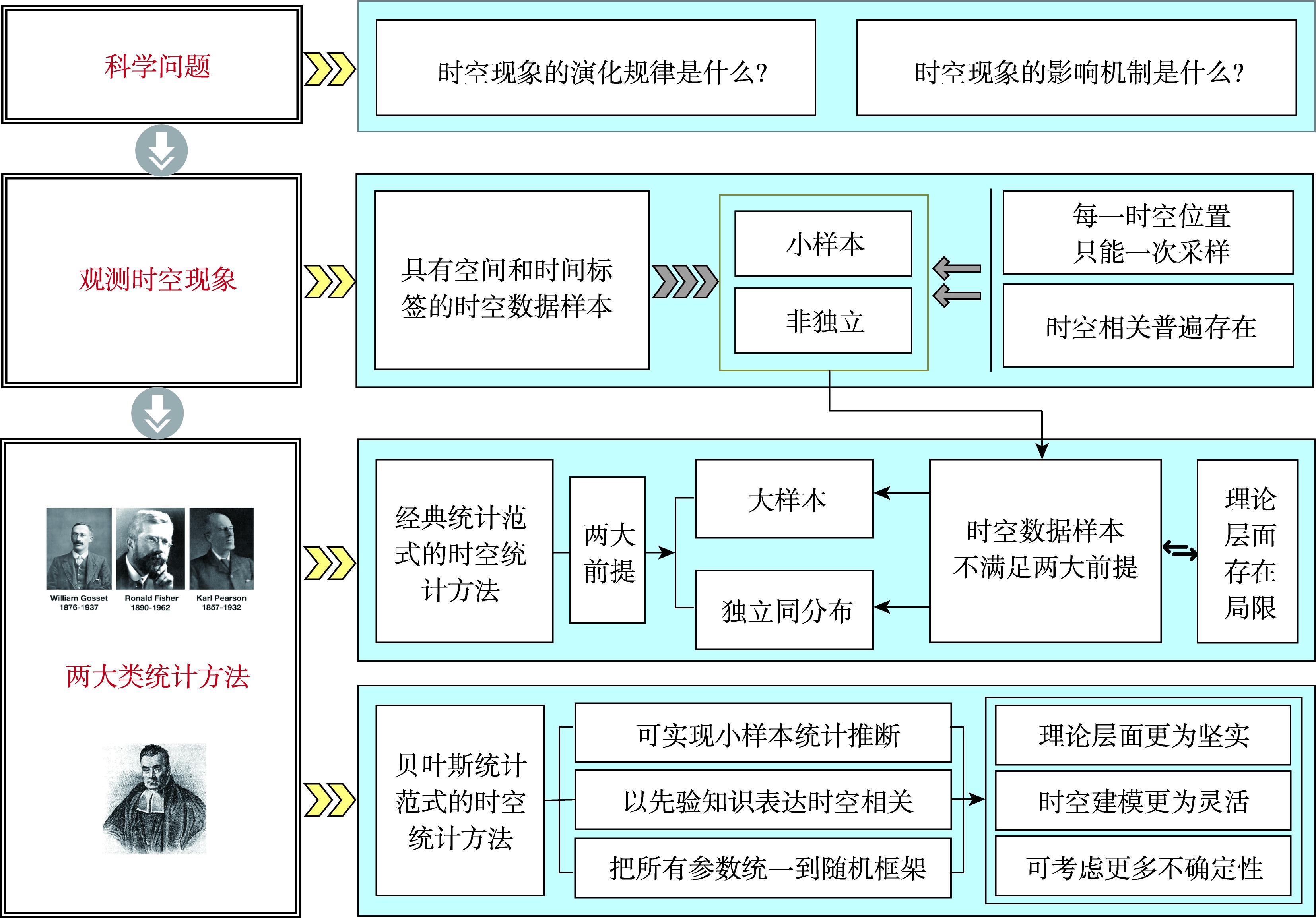

贝叶斯时空统计方法及应用进展与趋势
作者贡献:Author Contributions
李俊明、胡雅璇和王楠楠参与了内容构思、文献收集与初稿写作;王斯雅琦和王若兰参与了初稿写作;李俊明、吕琳和房紫晴参与了论文修改。所有作者均阅读并同意最终稿件的提交。
LI Junming, HU Yaxuan, and WANG Nannan contributed to the conceptualization, literature collection, and initial draft writing; WANG Siyaqi and WANG Ruolan contributed to the initial draft writing; LI Junming, LÜ Lin and FANG Ziqing contributed to the manuscript revision. All authors read and approved the final manuscript for submission.
|
李俊明(1979— ),男,山西太原人,博士,教授,主要从事贝叶斯时空统计方面的研究。E-mail: Lijunming_dr@126.com; Lijm@sxufe.edu.cn |
收稿日期: 2025-04-07
修回日期: 2025-06-17
网络出版日期: 2025-07-07
基金资助
国家社科基金重大项目(24&ZD183)
Advances and Trends in Bayesian Spatio-Temporal Statistical Methods and Applications
Received date: 2025-04-07
Revised date: 2025-06-17
Online published: 2025-07-07
Supported by
National Social Science Fund of China(Major Project)(24&ZD183)
【意义】经典统计推断依赖大样本与独立同分布前提,但时空数据却往往不满足这两大前提,因此,经典统计框架下的时空统计方法具有一定理论局限;相较而言,贝叶斯统计范式下的时空统计方法通过融合先验信息、引入参数随机性,形成统一的概率推断框架,可考虑更多不确定性,并能有效克服时空数据中的小样本和非独立问题,在时空统计建模中体现出较强的自身优势,并受到广泛关注和快速发展。【进展】本文首先从方法论演进角度出发,从传统贝叶斯时空统计与贝叶斯时空机器学习两个视角系统梳理了主流的贝叶斯时空统计模型,前者包括贝叶斯时空演化层次模型、贝叶斯时空回归层次模型、贝叶斯空间面板数据模型、贝叶斯时空地理加权回归模型、贝叶斯时空变系数模型和贝叶斯网格化时空高斯过程模型,后者包括贝叶斯时空因果森林模型、贝叶斯时空神经网络模型和贝叶斯时空图卷积神经网络模型;后又从实际应用方面,重点回顾了贝叶斯时空统计模型在公共卫生、环境科学、经济社会与公共安全、能源与工程等领域的应用。【展望】贝叶斯时空统计方法需在多源异构数据建模、深度学习融合、因果推断机制引入及高性能计算优化等方面实现突破,以兼顾理论完备性与实践适应性,推动其发展为具备因果推断、自适应泛化及智能分析的下一代时空建模范式。

李俊明 , 胡雅璇 , 王楠楠 , 王斯雅琦 , 王若兰 , 吕琳 , 房紫晴 . 贝叶斯时空统计方法及应用进展与趋势[J]. 地球信息科学学报, 2025 , 27(7) : 1501 -1519 . DOI: 10.12082/dqxxkx.2025.250161
[Objectives] Classical statistical inference typically relies on the assumptions of large sample sizes and independent, identically distributed (i.i.d.) observations, conditions that spatio-temporal data frequently violate, leading to inherent theoretical limitations in conventional approaches. In contrast, Bayesian spatio-temporal statistical methods integrate prior knowledge and treat all model parameters as random variables, thereby forming a unified probabilistic inference framework. This enables the incorporation of a broader range of uncertainties and offers robustness in modelling small samples and dependent structures, making Bayesian methods highly advantageous and increasingly influential in spatio-temporal analysis. [Progress] From the perspective of methodological evolution, this paper systematically reviews mainstream Bayesian spatio-temporal statistical models from two complementary perspectives: traditional Bayesian statistics and the Bayesian machine learning. The former includes Bayesian Spatio-temporal Evolutionary Hierarchical Models, Bayesian Spatio-temporal Regression Hierarchical Models, Bayesian Spatial Panel Data Models, Bayesian Geographically Weighted Spatio-temporal Regression Models, Bayesian Spatio-temporal Varying Coefficient Models, and Bayesian Spatio-temporal Meshed Gaussian Process Model. The latter includes Bayesian Causal Forest Models, Bayesian Spatio-temporal Neural Networks, and Bayesian Graph Convolutional Neural Networks. In terms of application, the review highlights representative studies across domains such as public health, environmental sciences, socio-economic and public safety, as well as energy and engineering. [Prospect] Bayesian spatio-temporal statistical methods need to achieve breakthroughs in multi-source heterogeneous data modeling, integration with deep learning, incorporation of causal inference mechanisms, and optimization of high-performance computing. These advances are essential to balance theoretical rigor with practical adaptability and to promote the development of a next-generation spatio-temporal modeling paradigm characterized by causal inference, adaptive generalization, and intelligent analysis.

表1 不同贝叶斯时空统计模型的优缺点对比Table 1 Comparison of the advantages and disadvantages of different Bayesian spatiotemporal statistical models |
| 方法类别 | 贝叶斯时空统计模型 | 模型优点 | 模型缺点 | |
|---|---|---|---|---|
| 传统统计模型 | 时空演化规律分析类 | 贝叶斯时空演化层次模型 (BSTEHM) | 可以捕捉总体和局部时空演化趋势 | 无法揭示时空影响机制 |
| 全局时空影响机制建模类 | 贝叶斯时空回归层次模型 (BSTRHM) | 可估计总体时空影响关系,解释性强 | 假设影响关系时空同质,不能捕捉时空异质性 | |
| 贝叶斯空间面板数据模型 (BSPDM) | 同时考虑时空动态效应,适合面板数据 | 假设影响关系时空同质,无法刻画局部时空差异 | ||
| 异质性时空局部建模类 | 贝叶斯时空地理加权回归 模型 (BSTGWR) | 强调局部时空异质性,灵活捕捉局部 时空差异 | 对空间权重敏感,存在边界效应,计算量较大 | |
| 贝叶斯时空变系数模型 (BSTVCM) | 时空动态参数变化灵活,体现局部 异质性 | 参数多且复杂,易过拟合,计算量较大 | ||
| 连续时空过程分析类 | 贝叶斯网格化时空高斯过 程模型 (BSTMGP) | 连续时空分析能力强,擅长分析大规模 时空数据 | 计算复杂度较高,实际应用受限 | |
| 机器学习模型 | 时空因果 推断类 | 贝叶斯时空因果森林模型 (BSTCFM) | 能有效识别高维复杂数据中的因果机制 | 模型结构复杂,参数解释与计算负担较高 |
| 时空深度 学习类 | 贝叶斯时空神经网络模型 (BSTNN) | 对非线性、高维时空依赖结构建模优势 明显;泛化能力强 | 参数规模大,计算负担重,解释性弱 | |
| 时空图学习类 | 贝叶斯时空图卷积神经网 络模型 (BSTGCNN) | 可捕捉复杂网络结构中时空交互效应, 图结构数据适应性极强 | 模型复杂度高,需较多计算资源,训练数据需求大 | |
利益冲突:Conflicts of Interest 所有作者声明不存在利益冲突。
All authors disclose no relevant conflicts of interest.
| [1] |
|
| [2] |
|
| [3] |
|
| [4] |
|
| [5] |
|
| [6] |
|
| [7] |
|
| [8] |
|
| [9] |
|
| [10] |
|
| [11] |
刘大千, 宋伟, 修春亮. 贝叶斯方法在犯罪时空格局研究上的应用——以长春市为例[J]. 地理科学, 2022, 42(5): 820-830.
[
|
| [12] |
|
| [13] |
|
| [14] |
|
| [15] |
韩秀兰, 崔月彤, 李俊明. 基于贝叶斯时空层次模型的中国宏观税负时空演化特征研究[J]. 统计与信息论坛, 2022, 37(8):67-74.
[
|
| [16] |
韩菲, 闫书淇. 环境保护税能否促进区域绿色全要素生产率增长——基于贝叶斯时空统计的实证研究[J]. 经济问题, 2023(7):103-112.
[
|
| [17] |
|
| [18] |
|
| [19] |
|
| [20] |
|
| [21] |
|
| [22] |
|
| [23] |
|
| [24] |
|
| [25] |
|
| [26] |
范真, 王西贝. 空间权重选择的模拟研究——基于贝叶斯方法[J]. 统计与决策, 2024, 40(10):52-57.
[
|
| [27] |
|
| [28] |
|
| [29] |
|
| [30] |
|
| [31] |
|
| [32] |
|
| [33] |
|
| [34] |
李俊明, 魏雯琪, 张鹏, 等. 中国市域数字经济发展对减污降碳协同的促进效应及其空间分异[J]. 经济地理, 2023, 43(12):169-180.
[
|
| [35] |
He,
|
| [36] |
|
| [37] |
|
| [38] |
|
| [39] |
|
| [40] |
|
| [41] |
|
| [42] |
|
| [43] |
|
| [44] |
|
| [45] |
|
| [46] |
|
| [47] |
|
| [48] |
|
| [49] |
|
| [50] |
|
| [51] |
|
| [52] |
敖琳珺, 张昱勤, 许欢, 等. 评估气象对广东省登革热时空预测模型的贡献[J]. 现代预防医学, 2020, 47(16):2899-2903.
[
|
| [53] |
|
| [54] |
|
| [55] |
张辉国, 岳铭, 胡锡健. 2018年新疆手足口病时空分布特征及气象因素相关性研究[J]. 病毒学报, 2022, 38(4):874-879.
[
|
| [56] |
陈思秇, 孙立梅, 马文军, 等. 基于贝叶斯时空模型广州市手足口病精细时空尺度下发病影响因素分析[J]. 中国公共卫生, 2020, 36(8):1171-1176.
[
|
| [57] |
|
| [58] |
|
| [59] |
|
| [60] |
|
| [61] |
|
| [62] |
|
| [63] |
|
| [64] |
|
| [65] |
|
| [66] |
陈胜亮, 靳思慧, 赵冬宝. 广东省县域内住院率时空特征及其影响因素分析[J]. 中国医院管理, 2024, 44(1):23-27.
[
|
| [67] |
李俊明. 中国PM2.5污染时空趋势研究——基于贝叶斯时空统计视角[J]. 统计与信息论坛, 2019, 34(6):67-73.
[
|
| [68] |
|
| [69] |
|
| [70] |
|
| [71] |
梁中耀, 余艳红, 王丽婧, 等. 湖泊水质时空变化特征识别的贝叶斯方差分析方法[J]. 环境科学学报, 2017, 37(11):4170-4177.
[
|
| [72] |
于明雪, 孙建国, 杨维涛. 基于贝叶斯层次时空模型的甘肃省土地利用程度演变分析[J]. 地理科学, 2022, 42(5):918-925.
[
|
| [73] |
吕建康, 孙建国, 谢甫. 贝叶斯层次时空模型在甘肃省AOD时空分布中的应用[J]. 无线电工程, 2023, 53(3):707-713.
[
|
| [74] |
李俊明. 基于Bayesian层次时空模型的我国老龄化分析与预测[J]. 统计研究, 2016, 33(8):89-94.
[
|
| [75] |
|
| [76] |
|
| [77] |
|
| [78] |
|
| [79] |
|
| [80] |
韩晓, 魏楚, 吴施美. 中国农村居民生物质能消费估计[J]. 资源科学, 2023, 45(9):1817-1829.
[
|
| [81] |
刘韵艺, 汤渊, 苏盛, 等. 基于STL-Bayesian时空模型的分布式光伏系统异常检测[J]. 中国电力, 2024, 57(5):222-231.
[
|
| [82] |
|
| [83] |
|
/
| 〈 |
|
〉 |